Arab Open University B291: Management Accounting Assignment Analysis
VerifiedAdded on 2023/01/19
|5
|1004
|65
Homework Assignment
AI Summary
This assignment analyzes Omantel's financial statements, focusing on management accounting principles. It examines the going concern assumption, emphasizing its importance for shareholder return and optimal capital structure, supported by Omantel's 2017 annual report data, including gearing ratios. The assignment also explores inventory valuation methods, specifically FIFO and LIFO, as per IAS2, referencing Omantel's annual report. Furthermore, it classifies Omantel's revenue recognition methods, such as completed contract, and discusses the appropriateness of these methods, including customer retention discounts, upgrade rights, portfolio accounting, and subsidized handsets. Finally, it summarizes Omantel's financial condition, highlighting the need to maintain the going concern assumption, carefully manage revenue recognition, and adapt to customer needs based on the financial statement.
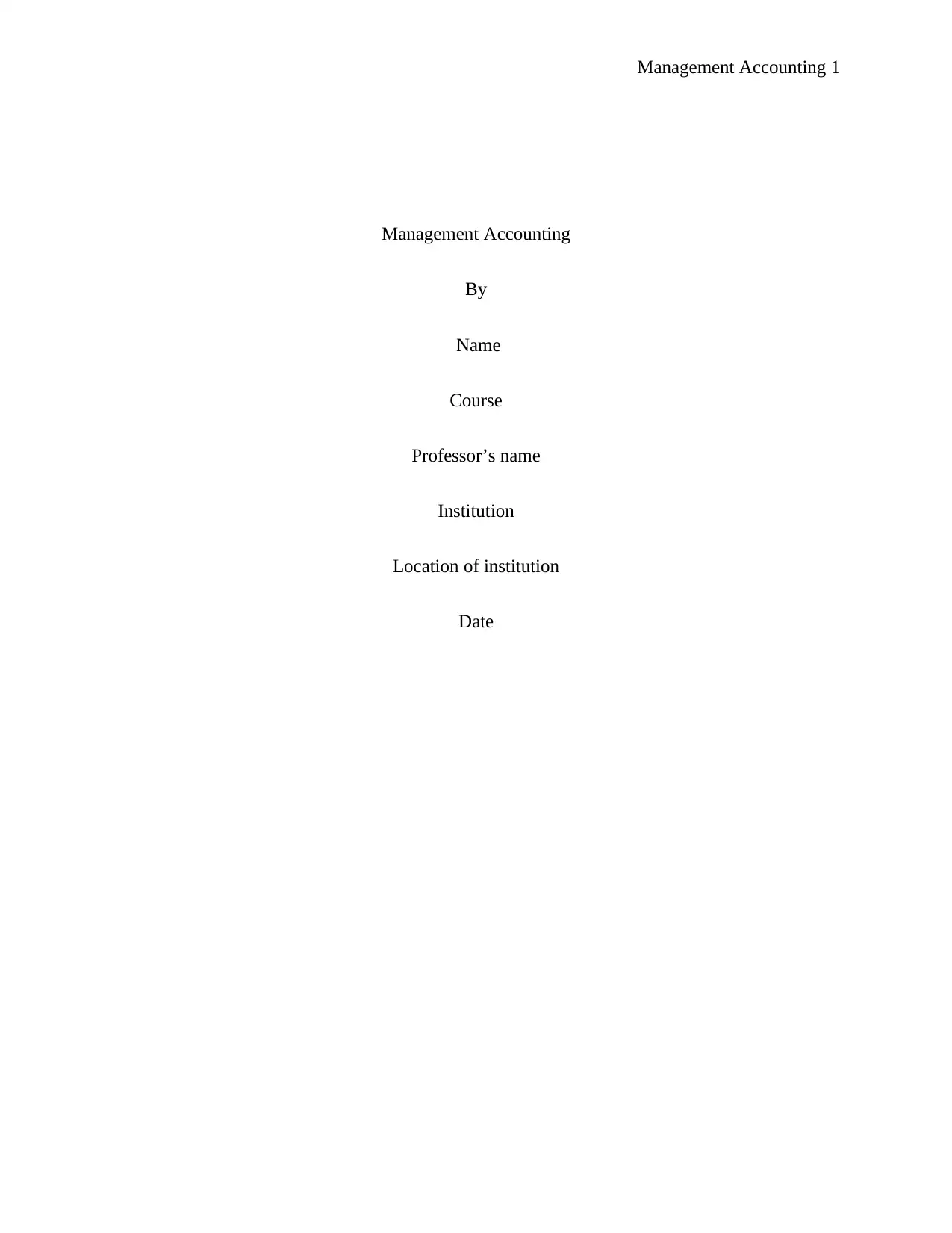
Management Accounting 1
Management Accounting
By
Name
Course
Professor’s name
Institution
Location of institution
Date
Management Accounting
By
Name
Course
Professor’s name
Institution
Location of institution
Date
Paraphrase This Document
Need a fresh take? Get an instant paraphrase of this document with our AI Paraphraser
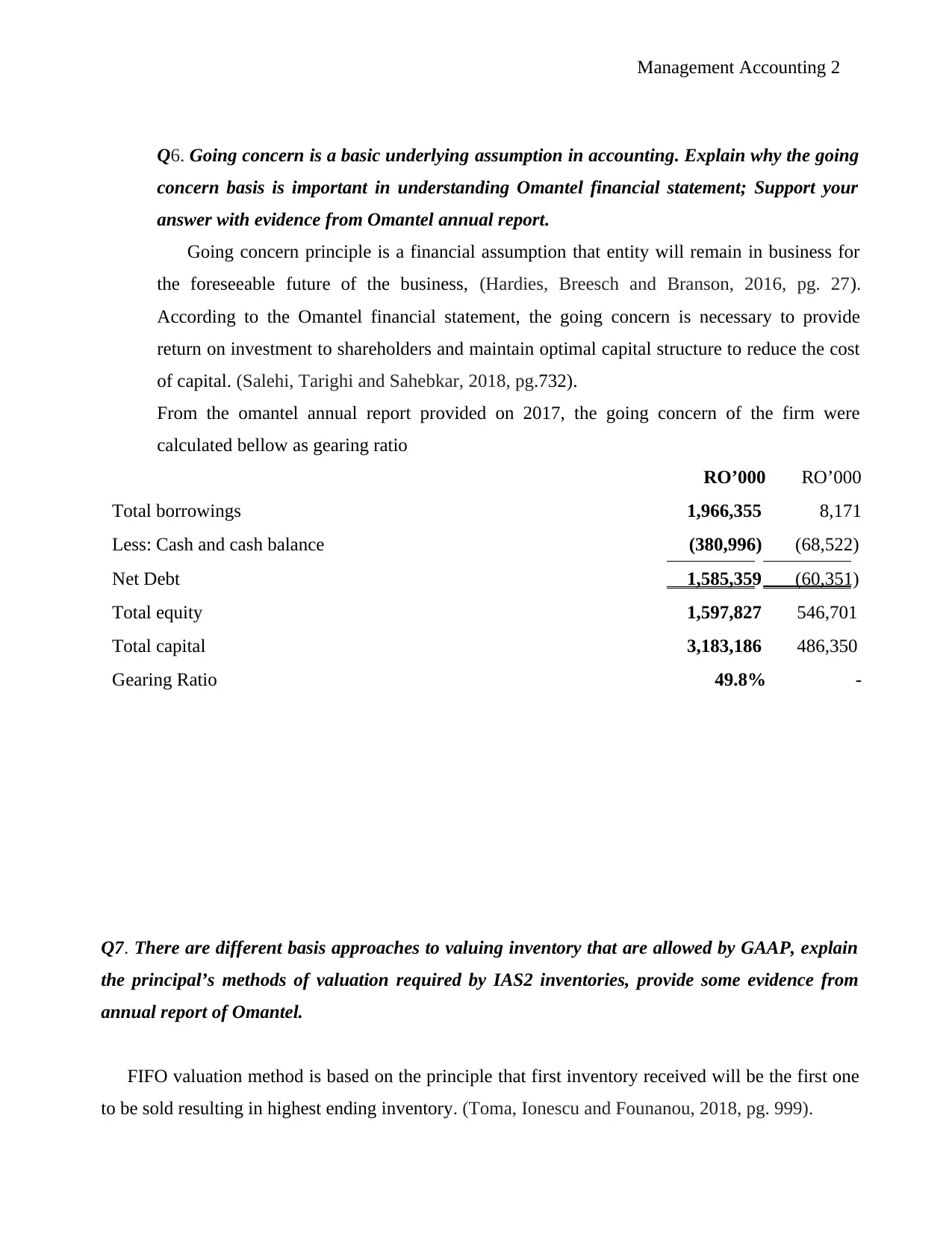
Management Accounting 2
Q6. Going concern is a basic underlying assumption in accounting. Explain why the going
concern basis is important in understanding Omantel financial statement; Support your
answer with evidence from Omantel annual report.
Going concern principle is a financial assumption that entity will remain in business for
the foreseeable future of the business, (Hardies, Breesch and Branson, 2016, pg. 27).
According to the Omantel financial statement, the going concern is necessary to provide
return on investment to shareholders and maintain optimal capital structure to reduce the cost
of capital. (Salehi, Tarighi and Sahebkar, 2018, pg.732).
From the omantel annual report provided on 2017, the going concern of the firm were
calculated bellow as gearing ratio
RO’000 RO’000
Total borrowings 1,966,355 8,171
Less: Cash and cash balance (380,996) (68,522)
Net Debt 1,585,359 (60,351)
Total equity 1,597,827 546,701
Total capital 3,183,186 486,350
Gearing Ratio 49.8% -
Q7. There are different basis approaches to valuing inventory that are allowed by GAAP, explain
the principal’s methods of valuation required by IAS2 inventories, provide some evidence from
annual report of Omantel.
FIFO valuation method is based on the principle that first inventory received will be the first one
to be sold resulting in highest ending inventory. (Toma, Ionescu and Founanou, 2018, pg. 999).
Q6. Going concern is a basic underlying assumption in accounting. Explain why the going
concern basis is important in understanding Omantel financial statement; Support your
answer with evidence from Omantel annual report.
Going concern principle is a financial assumption that entity will remain in business for
the foreseeable future of the business, (Hardies, Breesch and Branson, 2016, pg. 27).
According to the Omantel financial statement, the going concern is necessary to provide
return on investment to shareholders and maintain optimal capital structure to reduce the cost
of capital. (Salehi, Tarighi and Sahebkar, 2018, pg.732).
From the omantel annual report provided on 2017, the going concern of the firm were
calculated bellow as gearing ratio
RO’000 RO’000
Total borrowings 1,966,355 8,171
Less: Cash and cash balance (380,996) (68,522)
Net Debt 1,585,359 (60,351)
Total equity 1,597,827 546,701
Total capital 3,183,186 486,350
Gearing Ratio 49.8% -
Q7. There are different basis approaches to valuing inventory that are allowed by GAAP, explain
the principal’s methods of valuation required by IAS2 inventories, provide some evidence from
annual report of Omantel.
FIFO valuation method is based on the principle that first inventory received will be the first one
to be sold resulting in highest ending inventory. (Toma, Ionescu and Founanou, 2018, pg. 999).
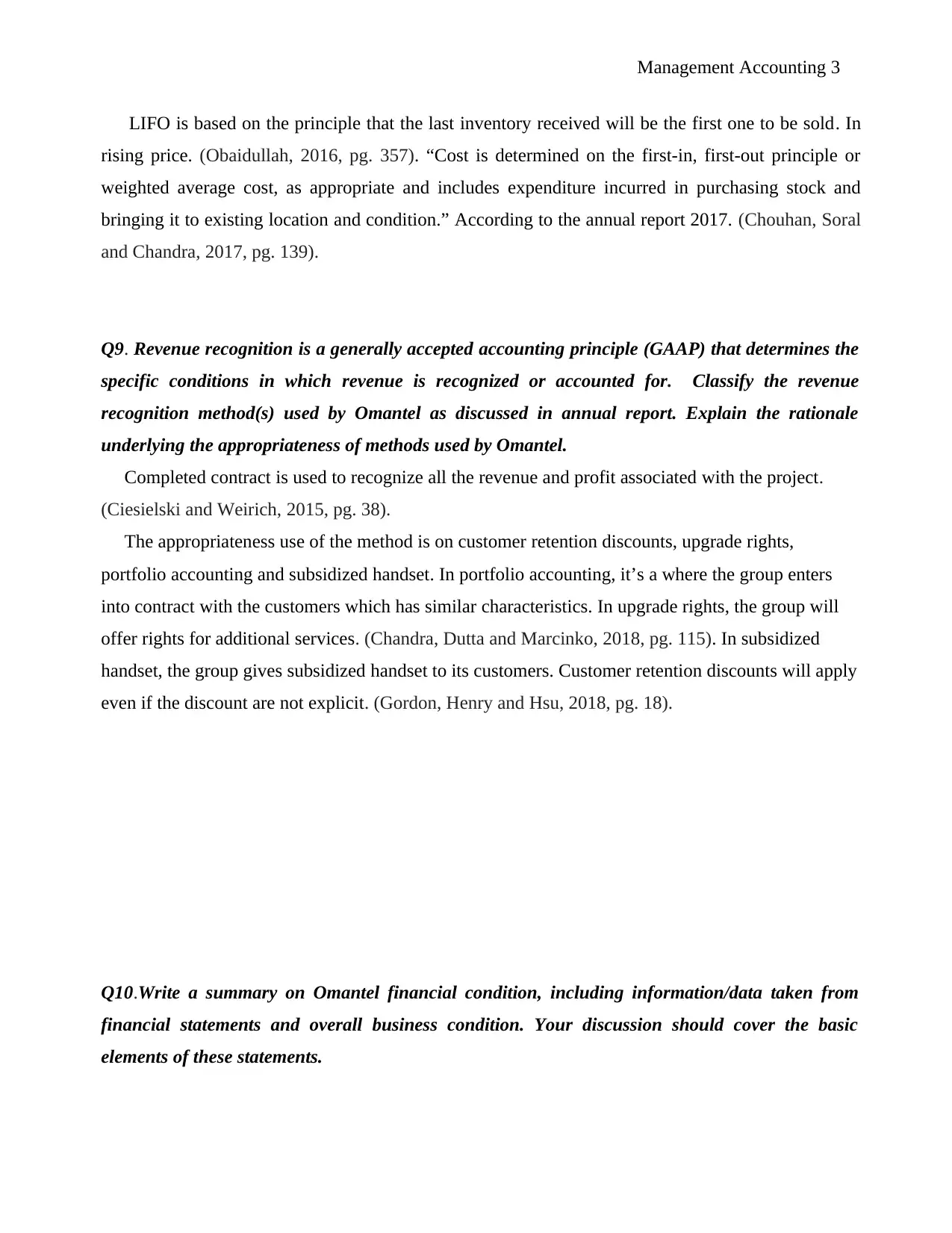
Management Accounting 3
LIFO is based on the principle that the last inventory received will be the first one to be sold. In
rising price. (Obaidullah, 2016, pg. 357). “Cost is determined on the first-in, first-out principle or
weighted average cost, as appropriate and includes expenditure incurred in purchasing stock and
bringing it to existing location and condition.” According to the annual report 2017. (Chouhan, Soral
and Chandra, 2017, pg. 139).
Q9. Revenue recognition is a generally accepted accounting principle (GAAP) that determines the
specific conditions in which revenue is recognized or accounted for. Classify the revenue
recognition method(s) used by Omantel as discussed in annual report. Explain the rationale
underlying the appropriateness of methods used by Omantel.
Completed contract is used to recognize all the revenue and profit associated with the project.
(Ciesielski and Weirich, 2015, pg. 38).
The appropriateness use of the method is on customer retention discounts, upgrade rights,
portfolio accounting and subsidized handset. In portfolio accounting, it’s a where the group enters
into contract with the customers which has similar characteristics. In upgrade rights, the group will
offer rights for additional services. (Chandra, Dutta and Marcinko, 2018, pg. 115). In subsidized
handset, the group gives subsidized handset to its customers. Customer retention discounts will apply
even if the discount are not explicit. (Gordon, Henry and Hsu, 2018, pg. 18).
Q10.Write a summary on Omantel financial condition, including information/data taken from
financial statements and overall business condition. Your discussion should cover the basic
elements of these statements.
LIFO is based on the principle that the last inventory received will be the first one to be sold. In
rising price. (Obaidullah, 2016, pg. 357). “Cost is determined on the first-in, first-out principle or
weighted average cost, as appropriate and includes expenditure incurred in purchasing stock and
bringing it to existing location and condition.” According to the annual report 2017. (Chouhan, Soral
and Chandra, 2017, pg. 139).
Q9. Revenue recognition is a generally accepted accounting principle (GAAP) that determines the
specific conditions in which revenue is recognized or accounted for. Classify the revenue
recognition method(s) used by Omantel as discussed in annual report. Explain the rationale
underlying the appropriateness of methods used by Omantel.
Completed contract is used to recognize all the revenue and profit associated with the project.
(Ciesielski and Weirich, 2015, pg. 38).
The appropriateness use of the method is on customer retention discounts, upgrade rights,
portfolio accounting and subsidized handset. In portfolio accounting, it’s a where the group enters
into contract with the customers which has similar characteristics. In upgrade rights, the group will
offer rights for additional services. (Chandra, Dutta and Marcinko, 2018, pg. 115). In subsidized
handset, the group gives subsidized handset to its customers. Customer retention discounts will apply
even if the discount are not explicit. (Gordon, Henry and Hsu, 2018, pg. 18).
Q10.Write a summary on Omantel financial condition, including information/data taken from
financial statements and overall business condition. Your discussion should cover the basic
elements of these statements.
⊘ This is a preview!⊘
Do you want full access?
Subscribe today to unlock all pages.

Trusted by 1+ million students worldwide
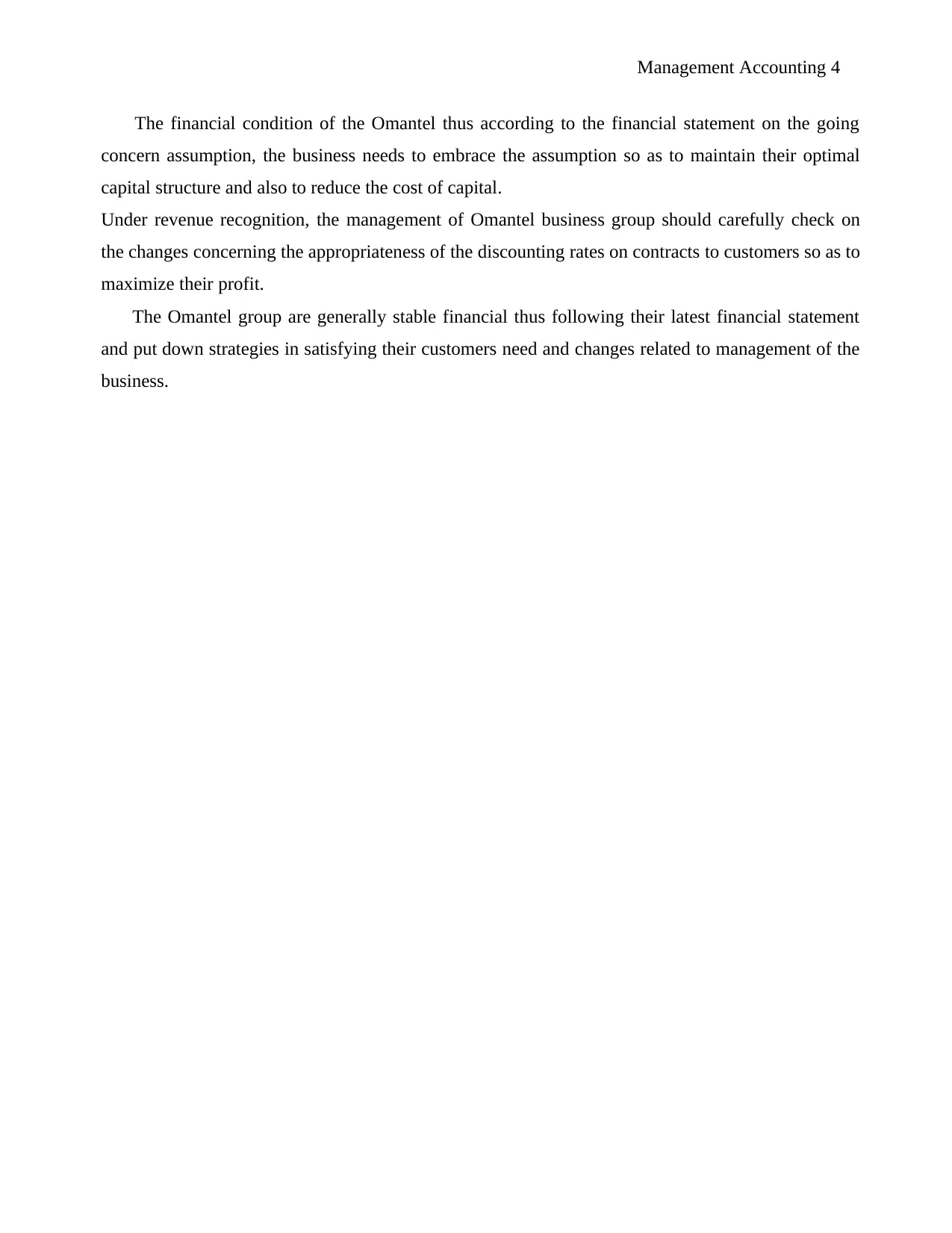
Management Accounting 4
The financial condition of the Omantel thus according to the financial statement on the going
concern assumption, the business needs to embrace the assumption so as to maintain their optimal
capital structure and also to reduce the cost of capital.
Under revenue recognition, the management of Omantel business group should carefully check on
the changes concerning the appropriateness of the discounting rates on contracts to customers so as to
maximize their profit.
The Omantel group are generally stable financial thus following their latest financial statement
and put down strategies in satisfying their customers need and changes related to management of the
business.
The financial condition of the Omantel thus according to the financial statement on the going
concern assumption, the business needs to embrace the assumption so as to maintain their optimal
capital structure and also to reduce the cost of capital.
Under revenue recognition, the management of Omantel business group should carefully check on
the changes concerning the appropriateness of the discounting rates on contracts to customers so as to
maximize their profit.
The Omantel group are generally stable financial thus following their latest financial statement
and put down strategies in satisfying their customers need and changes related to management of the
business.
Paraphrase This Document
Need a fresh take? Get an instant paraphrase of this document with our AI Paraphraser
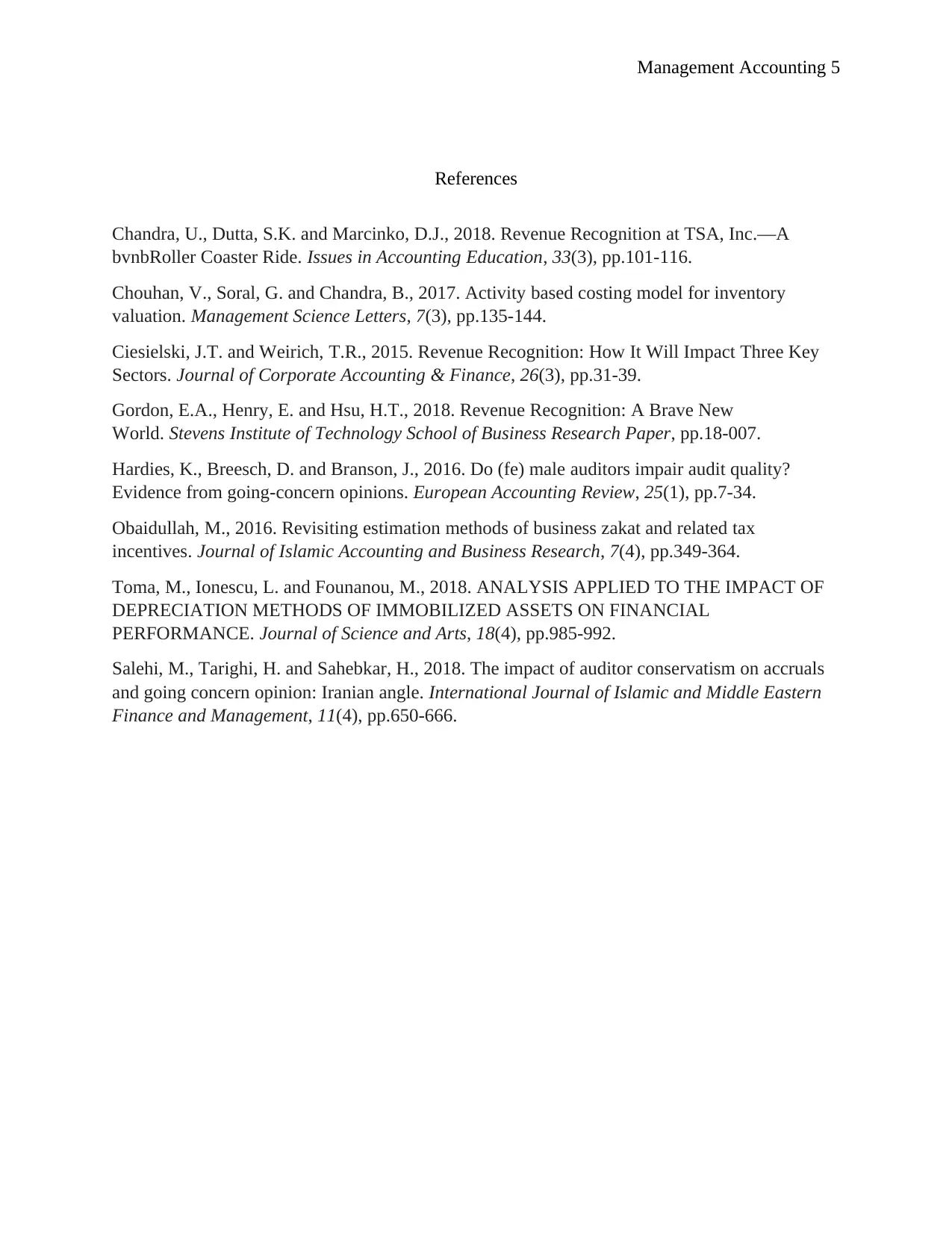
Management Accounting 5
References
Chandra, U., Dutta, S.K. and Marcinko, D.J., 2018. Revenue Recognition at TSA, Inc.—A
bvnbRoller Coaster Ride. Issues in Accounting Education, 33(3), pp.101-116.
Chouhan, V., Soral, G. and Chandra, B., 2017. Activity based costing model for inventory
valuation. Management Science Letters, 7(3), pp.135-144.
Ciesielski, J.T. and Weirich, T.R., 2015. Revenue Recognition: How It Will Impact Three Key
Sectors. Journal of Corporate Accounting & Finance, 26(3), pp.31-39.
Gordon, E.A., Henry, E. and Hsu, H.T., 2018. Revenue Recognition: A Brave New
World. Stevens Institute of Technology School of Business Research Paper, pp.18-007.
Hardies, K., Breesch, D. and Branson, J., 2016. Do (fe) male auditors impair audit quality?
Evidence from going-concern opinions. European Accounting Review, 25(1), pp.7-34.
Obaidullah, M., 2016. Revisiting estimation methods of business zakat and related tax
incentives. Journal of Islamic Accounting and Business Research, 7(4), pp.349-364.
Toma, M., Ionescu, L. and Founanou, M., 2018. ANALYSIS APPLIED TO THE IMPACT OF
DEPRECIATION METHODS OF IMMOBILIZED ASSETS ON FINANCIAL
PERFORMANCE. Journal of Science and Arts, 18(4), pp.985-992.
Salehi, M., Tarighi, H. and Sahebkar, H., 2018. The impact of auditor conservatism on accruals
and going concern opinion: Iranian angle. International Journal of Islamic and Middle Eastern
Finance and Management, 11(4), pp.650-666.
References
Chandra, U., Dutta, S.K. and Marcinko, D.J., 2018. Revenue Recognition at TSA, Inc.—A
bvnbRoller Coaster Ride. Issues in Accounting Education, 33(3), pp.101-116.
Chouhan, V., Soral, G. and Chandra, B., 2017. Activity based costing model for inventory
valuation. Management Science Letters, 7(3), pp.135-144.
Ciesielski, J.T. and Weirich, T.R., 2015. Revenue Recognition: How It Will Impact Three Key
Sectors. Journal of Corporate Accounting & Finance, 26(3), pp.31-39.
Gordon, E.A., Henry, E. and Hsu, H.T., 2018. Revenue Recognition: A Brave New
World. Stevens Institute of Technology School of Business Research Paper, pp.18-007.
Hardies, K., Breesch, D. and Branson, J., 2016. Do (fe) male auditors impair audit quality?
Evidence from going-concern opinions. European Accounting Review, 25(1), pp.7-34.
Obaidullah, M., 2016. Revisiting estimation methods of business zakat and related tax
incentives. Journal of Islamic Accounting and Business Research, 7(4), pp.349-364.
Toma, M., Ionescu, L. and Founanou, M., 2018. ANALYSIS APPLIED TO THE IMPACT OF
DEPRECIATION METHODS OF IMMOBILIZED ASSETS ON FINANCIAL
PERFORMANCE. Journal of Science and Arts, 18(4), pp.985-992.
Salehi, M., Tarighi, H. and Sahebkar, H., 2018. The impact of auditor conservatism on accruals
and going concern opinion: Iranian angle. International Journal of Islamic and Middle Eastern
Finance and Management, 11(4), pp.650-666.
1 out of 5
Your All-in-One AI-Powered Toolkit for Academic Success.
+13062052269
info@desklib.com
Available 24*7 on WhatsApp / Email
![[object Object]](/_next/static/media/star-bottom.7253800d.svg)
Unlock your academic potential
Copyright © 2020–2025 A2Z Services. All Rights Reserved. Developed and managed by ZUCOL.

